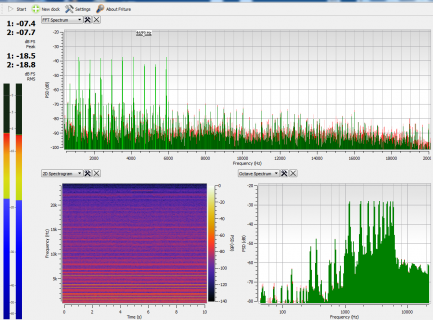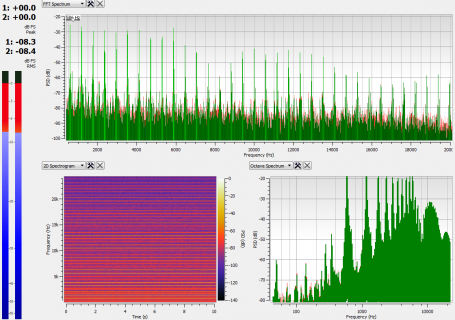Rados_dubna
Member
Hello,
That should be something simple but looks strange.
I have a simple idea to test the simultaneous generation of 20 tones. For that I use a Teensy 3.2 and a Teensy Audio board.
I have drawn in the web GUI a simple scheme where I have 20 x AudioSynthWaveform objects connected to 5 x AudioMixer objects and those in turn are connected to 2 x AudioMixer and finally we go into a AudioOutputI2S.
Then I initiate the 20 x AudioSynthWaveform with Waveform.amplitude(1.0/20); so that the summ of all the 20 amplitudes is always <= 1.0 and the Waveform_N.frequency(F0 + F0*N); . All the AudioMIxers are set to linear summ of the inputs - mixer1.gain(0,1.0); . To control the volume I use the sgtl5000_1.volume(X); , I know that there is also the sgtl5000_1.dacVolume(Y); but I did not get how it relates to the .volume(X) , so I simply did not use it.
The Problem:
If I start with a low sgtl5000_1.volume(0.2) I get a nice output of the Waveforms (here 10 but identical with 20):
At sgtl5000_1.volume(0.3) it is still working (but actually is too quite to listen):

But anything higher than ~0.33 in the main volume setting gives:

Actually if I use a potentiometer to change live the sgtl5000_1.volume(X); I get a very net change of the behavior at that volume setting.
I think that I do something wrong in how I control the volume, but did not find the solution yet.
The code below is for 10 tones but for me it is working exactly the same as for 20. After the code is loaded one need to use the serial terminal to press 0 -9 value that will switch on/off the respective tone and the main volume is to be changed in the code before the compilation.
Any suggestion is welcome. Thanks.
That should be something simple but looks strange.
I have a simple idea to test the simultaneous generation of 20 tones. For that I use a Teensy 3.2 and a Teensy Audio board.
I have drawn in the web GUI a simple scheme where I have 20 x AudioSynthWaveform objects connected to 5 x AudioMixer objects and those in turn are connected to 2 x AudioMixer and finally we go into a AudioOutputI2S.
Then I initiate the 20 x AudioSynthWaveform with Waveform.amplitude(1.0/20); so that the summ of all the 20 amplitudes is always <= 1.0 and the Waveform_N.frequency(F0 + F0*N); . All the AudioMIxers are set to linear summ of the inputs - mixer1.gain(0,1.0); . To control the volume I use the sgtl5000_1.volume(X); , I know that there is also the sgtl5000_1.dacVolume(Y); but I did not get how it relates to the .volume(X) , so I simply did not use it.
The Problem:
If I start with a low sgtl5000_1.volume(0.2) I get a nice output of the Waveforms (here 10 but identical with 20):

At sgtl5000_1.volume(0.3) it is still working (but actually is too quite to listen):

But anything higher than ~0.33 in the main volume setting gives:

Actually if I use a potentiometer to change live the sgtl5000_1.volume(X); I get a very net change of the behavior at that volume setting.
I think that I do something wrong in how I control the volume, but did not find the solution yet.
The code below is for 10 tones but for me it is working exactly the same as for 20. After the code is loaded one need to use the serial terminal to press 0 -9 value that will switch on/off the respective tone and the main volume is to be changed in the code before the compilation.
Code:
#include <Audio.h>
#include <Wire.h>
#include <SPI.h>
#include <SD.h>
#include <SerialFlash.h>
// GUItool: begin automatically generated code
AudioSynthWaveform waveform6; //xy=96,558
AudioSynthWaveform waveform7; //xy=108,607
AudioSynthWaveform waveform8; //xy=109,653
AudioSynthWaveform waveform5; //xy=110,516
AudioSynthWaveform waveform9; //xy=113,707
AudioSynthWaveform waveform10; //xy=115,754
AudioSynthWaveform waveform1; //xy=118,325
AudioSynthWaveform waveform2; //xy=118,370
AudioSynthWaveform waveform4; //xy=119,464
AudioSynthWaveform waveform3; //xy=120,416
AudioMixer4 mixer1; //xy=357,388
AudioMixer4 mixer2; //xy=359,562
AudioMixer4 mixer3; //xy=361,741
AudioMixer4 mixer4; //xy=596,540
AudioOutputI2S i2s1; //xy=806,525
AudioConnection patchCord1(waveform6, 0, mixer2, 1);
AudioConnection patchCord2(waveform7, 0, mixer2, 2);
AudioConnection patchCord3(waveform8, 0, mixer2, 3);
AudioConnection patchCord4(waveform5, 0, mixer2, 0);
AudioConnection patchCord5(waveform9, 0, mixer3, 0);
AudioConnection patchCord6(waveform10, 0, mixer3, 1);
AudioConnection patchCord7(waveform1, 0, mixer1, 0);
AudioConnection patchCord8(waveform2, 0, mixer1, 1);
AudioConnection patchCord9(waveform4, 0, mixer1, 3);
AudioConnection patchCord10(waveform3, 0, mixer1, 2);
AudioConnection patchCord11(mixer1, 0, mixer4, 0);
AudioConnection patchCord12(mixer2, 0, mixer4, 1);
AudioConnection patchCord13(mixer3, 0, mixer4, 2);
AudioConnection patchCord14(mixer4, 0, i2s1, 0);
AudioConnection patchCord15(mixer4, 0, i2s1, 1);
AudioControlSGTL5000 sgtl5000_1; //xy=614,187
// GUItool: end automatically generated code
int inByte = 0;
int call_N = 0;
const int N_waves = 10;
AudioSynthWaveform * Waves[N_waves] =
{
&waveform1, &waveform2, &waveform3, &waveform4, &waveform5, &waveform6, &waveform7, &waveform8, &waveform9, &waveform10
};
float Note_list[][N_waves] =
{
{587.33 , 1174.66 , 1761.99 , 2349.32 , 2936.65 , 3523.98 , 4111.31 , 4698.64 , 5285.97 , 5873.3},
{739.99 , 1479.98 , 2219.97 , 2959.96 , 3699.95 , 4439.94 , 5179.93 , 5919.92 , 6659.91 , 7399.9},
{830.61 , 1661.22 , 2491.83 , 3322.44 , 4153.05 , 4983.66 , 5814.26 , 6644.88 , 7475.49 , 8306.1},
{987.77 , 1975.54 , 2963.31 , 3951.08 , 4938.85 , 5926.62 , 6914.39 , 7902.16 , 8889.93 , 9877.7}
};
float Tone_state[N_waves] = {0};
int set_note(int N_note)
{
AudioNoInterrupts();
for(int i=0; i < N_waves; ++i)
{
Tone_state[i] = 0.1;
Waves[i]-> frequency(Note_list[N_note][i]);
Waves[i]-> amplitude( Tone_state[i] );
Waves[i]-> phase(0.0);
}
AudioInterrupts();
for(int i=0; i < N_waves; ++i)
{
Waves[i]-> begin(WAVEFORM_SINE);
}
Serial.print("Reproducing the note N-");
Serial.println(N_note);
return 0;
}
int toggle_tone(int N_tone)
{
if(Tone_state[N_tone] == 0)
{
Tone_state[N_tone] = 0.1;
}
else
{
Tone_state[N_tone] = 0.0;
}
AudioNoInterrupts();
Waves[N_tone]-> amplitude(Tone_state[N_tone]);
AudioInterrupts();
Serial.print("Tone N-");
Serial.print(N_tone);
Serial.print(", changing volume to ");
Serial.println(Tone_state[N_tone]);
return 0;
}
void setup() {
Serial.begin(9600);
while (!Serial && millis() < 2500) ; // wait
establishContact();
Serial.println("Ready!");
AudioMemory(20);
analogReference(INTERNAL);
mixer1.gain(0,1.0);
mixer1.gain(1,1.0);
mixer1.gain(2,1.0);
mixer1.gain(3,1.0);
mixer2.gain(0,1.0);
mixer2.gain(1,1.0);
mixer2.gain(2,1.0);
mixer2.gain(3,1.0);
mixer3.gain(0,1.0);
mixer3.gain(1,1.0);
mixer4.gain(0,1.0);
mixer4.gain(1,1.0);
mixer4.gain(2,1.0);
mixer4.gain(3,1.0);
set_note(0);
sgtl5000_1.enable();
sgtl5000_1.volume(0.2); // set the main volume...
sgtl5000_1.adcHighPassFilterDisable();
// sgtl5000_1.dacVolume(0.5); // set the "dac" volume (extra control)
// sgtl5000_1.dacVolumeRampDisable();
}
void loop() {
if (Serial.available() > 0)
{
inByte = Serial.read() - 48;
Serial.print(inByte);
Serial.print(" Call N-");
Serial.println(call_N);
++call_N;
if(inByte >= 0 && inByte <= 9)
{
toggle_tone(inByte);
}
else if(inByte == 65 || inByte == 71 || inByte == 53 || inByte == 66)
{
if(inByte == 65)
{
set_note(0);
}
else if(inByte == 71)
{
set_note(1);
}
else if(inByte == 53)
{
set_note(2);
}
else if(inByte == 66)
{
set_note(3);
}
}
else if(inByte == 67)
{
}
else
{
Serial.println("Wrong argument");
}
delay(300);
}
}
void establishContact() {
while (Serial.available() <= 0) {
Serial.print('A'); // send a capital A
delay(300);
}
}Any suggestion is welcome. Thanks.

